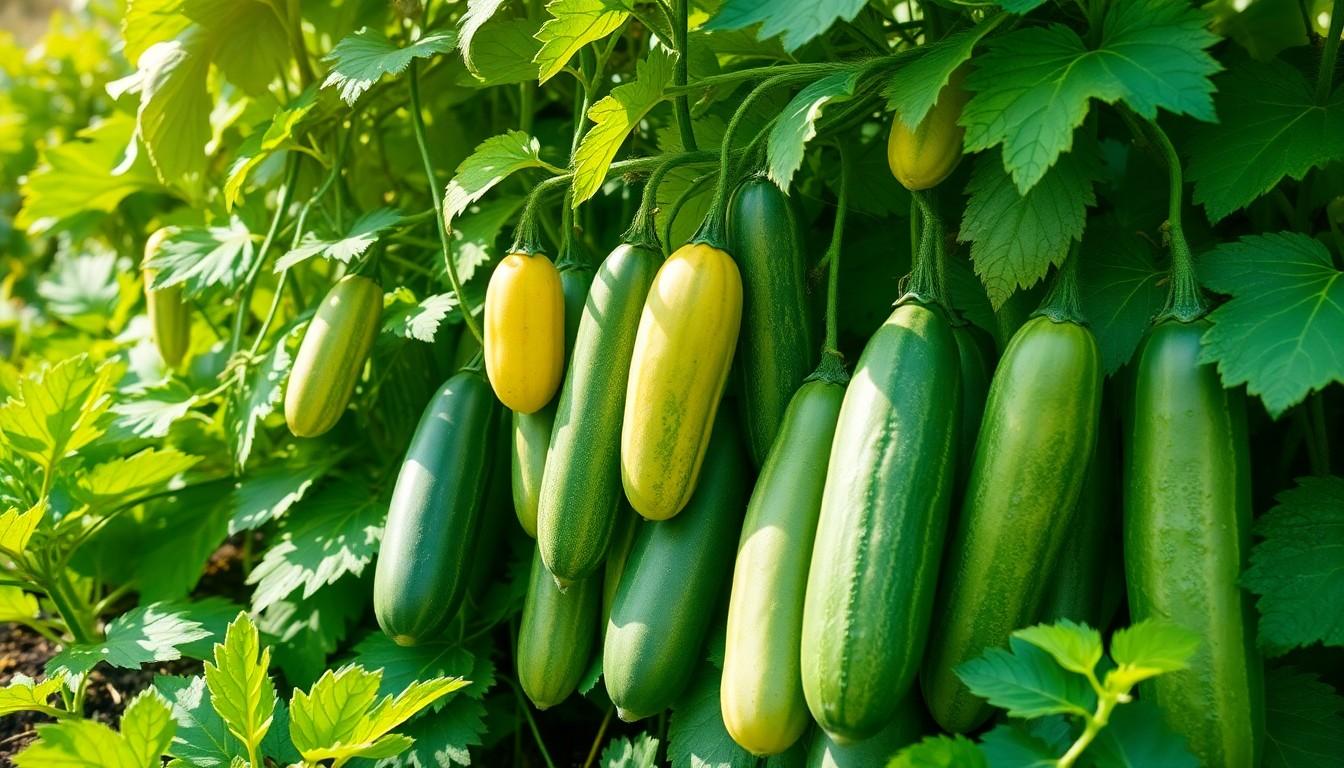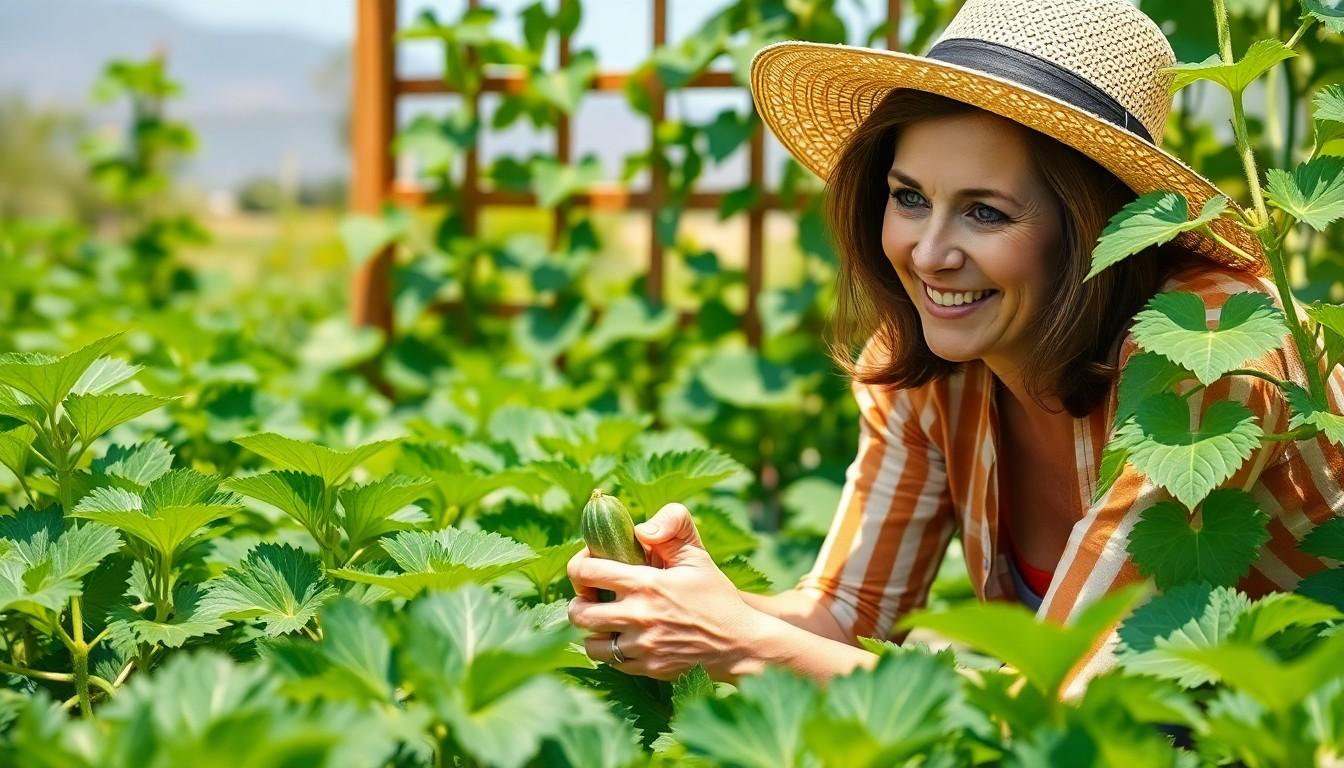Cucumbers are the cool kids of the garden world, bringing crunch and refreshment to summer salads and pickles. But growing these green wonders isn’t just a walk in the park; it requires a bit of finesse and a sprinkle of know-how. Whether you’re a seasoned gardener or a newbie with dreams of a cucumber empire, mastering the art of cucumber gardening can turn your backyard into a veggie paradise.
Cucumber Gardening Tips
Choose a sunny location for planting cucumbers. Cucumbers thrive in full sun with at least six to eight hours of direct sunlight daily. Use well-draining soil enriched with organic matter. Incorporating compost improves soil fertility and drainage.
Select the right cucumber variety based on growing conditions. Slicing cucumbers perform well in gardens, while pickling varieties are ideal for canning. Space plants adequately to promote air circulation. A distance of 36 inches between rows helps reduce disease risk.
Water cucumbers consistently, especially during dry spells. Maintaining soil moisture supports healthy growth and fruit development. Employ mulch to retain moisture and suppress weeds. Organic mulch, such as straw or wood chips, effectively conserves soil humidity.
Fertilize cucumbers with a balanced fertilizer. Applying fertilizer every few weeks boosts growth and fruit production. Watch for pests like cucumber beetles or aphids. Implementing natural pest control methods, such as introducing beneficial insects, minimizes damage while protecting the ecosystem.
Train cucumbers on trellises to maximize space and improve air circulation. Vertical growing also reduces the risk of rot caused by soil contact. Harvest cucumbers regularly, ideally when they reach six to eight inches long. Frequent harvesting encourages continuous production and maintains plant vigor.
Monitor for diseases such as powdery mildew. Implementing crop rotation helps manage soil-borne diseases. Engaging in these cucumber gardening tips ensures a bountiful harvest and a thriving garden.
Choosing the Right Variety
Selecting the right cucumber variety enhances gardening success. Each type serves different culinary purposes and growth conditions.
Pickling vs. Slicing Cucumbers
Pickling cucumbers, like ‘Kirby’ and ‘Boston Pickling,’ are smaller and thicker-skinned, making them ideal for preserves. Slicing cucumbers, such as ‘English’ and ‘Marketmore,’ have a smoother, longer shape suited for fresh consumption. Heirloom options, including ‘Lemon’ cucumbers, add unique flavors and visuals. A gardener should choose based on their intended use, ensuring they plant the varieties best suited to their preferences.
Disease-Resistant Varieties
Choosing disease-resistant varieties minimizes gardening challenges. Varieties like ‘Eureka’ and ‘Diva’ resist common cucumber diseases, including powdery mildew and cucumber beetles. These options thrive in various conditions, making them suitable for different climates. Selecting them boosts harvest potential while reducing the need for chemical treatments. Researching local conditions helps gardeners make informed decisions about which resistant types to plant.
Soil Preparation and Fertility
Preparing the soil for cucumber gardening is crucial for optimal growth and yield. Proper soil fertility ensures strong, healthy plants.
Soil Testing and Amendments
Conducting soil tests reveals essential nutrient levels and pH balance. Test results guide amendments tailored to the garden’s specific needs, improving nutrient availability. Adding compost enhances soil structure and enriches organic matter content. Incorporating elements, such as lime for acidity adjustment and sulfur for alkalinity mitigation, promotes ideal cucumber growing conditions. Organic matter improves drainage and moisture retention, creating a supportive environment for root development.
Organic vs. Synthetic Fertilizers
Choosing between organic and synthetic fertilizers can impact cucumber growth. Organic alternatives, like compost or manure, provide slow-release nutrients and improve soil health over time. Synthetic fertilizers deliver quick nutrient availability, promoting rapid plant growth but may pose a risk of nutrient runoff. To strike a balance, use organic fertilizers as a foundation while supplementing with synthetic options when necessary. Monitoring plant response and adjusting fertilization practices contribute to maximizing yields in cucumber gardening.
Planting Techniques
Planting cucumbers involves specific methods to ensure strong growth and healthy yields. Effective techniques vary for starting seeds indoors or sowing directly in the garden.
Seed Starting Indoors
Start cucumber seeds indoors about 4 to 6 weeks before the last frost date. Use seed trays filled with sterile seed-starting mix for optimal germination. Ensure warmth by placing trays near a heat source or using heating mats; temperatures around 70 to 90 degrees Fahrenheit enhance sprouting. Maintain moisture by misting the soil lightly, but avoid waterlogging, which can hinder growth. Once seedlings develop two to three true leaves, transplant them into larger pots, providing adequate space for root development. Harden off seedlings gradually before transplanting outdoors to prevent transplant shock.
Direct Sowing in the Garden
Direct sowing involves planting cucumber seeds in the garden once the soil temperature reaches at least 60 degrees Fahrenheit. Choose a sunny spot with well-draining soil to maximize growth potential. Plant seeds about 1 inch deep and spaced 12 to 18 inches apart for proper air circulation. Water thoroughly after sowing, and keep the soil consistently moist during germination. If pests or cool weather threaten young plants, consider covering them with row covers. Thinning seedlings to the strongest 2 or 3 per hill encourages healthy development and improves overall yield.
Watering and Care
Watering cucumbers entails providing consistent moisture for optimal growth and yield. Cucumbers prefer evenly moist soil, as dehydration can lead to stress, impacting both taste and texture. Regular watering, especially during dry periods, ensures healthy vine development and fruit formation. A deep watering schedule encourages roots to grow stronger and reach for moisture, improving drought resistance. Observing the plants can help determine when to water; wilting leaves often indicate they require more hydration.
Importance of Consistent Moisture
Consistent moisture supports healthy cucumber plants throughout their growth stages. When moisture remains stable, plants can absorb nutrients effectively, leading to better fruit quality. Fluctuating soil moisture levels stunt growth, resulting in misshapen fruits and reduced harvest. Applying approximately one to two inches of water per week is ideal during peak growing seasons. Additionally, using a soil moisture meter can provide guidance on watering needs, ensuring that plants thrive.
Mulching for Temperature Regulation
Mulching plays a crucial role in regulating soil temperature and moisture retention. Organic materials, like straw or wood chips, help maintain consistent moisture levels while preventing weeds. A layer of mulch also moderates soil temperature, keeping it cooler during hot weather, which cucumbers favor. Applying mulch benefits root systems by protecting them from temperature extremes and reducing evaporation. Effective mulching can enhance the overall health of cucumber plants, promoting a more fruitful growing season.
Pest and Disease Management
Healthy cucumber plants require vigilance against pests and diseases. Monitoring plants regularly helps in early detection, leading to better management results.
Common Pests to Watch For
Cucumber beetles, aphids, and spider mites commonly affect cucumber gardens. Cucumber beetles can cause significant damage by feeding on leaves and transmitting diseases. Aphids cluster on young growth and sap nutrients, weakening plants. Spider mites thrive in dry conditions, often resulting in yellowed leaves and webbing. Identifying these pests early enables gardeners to employ effective control measures.
Organic Control Methods
Natural solutions exist for managing pests organically. Introducing beneficial insects, such as ladybugs and lacewings, can help control aphid populations. Neem oil acts as a repellent and disrupts pest development. Insecticidal soaps provide another option, smothering soft-bodied insects without harming beneficial species. Applying diatomaceous earth creates a barrier against crawling pests. Regularly inspecting plants and promptly addressing infestations ensures healthy cucumber growth.
Harvesting and Storage
Cucumbers require timely harvesting for peak flavor and texture. Understanding when to pick them ensures optimal quality.
When to Harvest Cucumbers
Harvest cucumbers once they reach 6 to 8 inches in length, maintaining a firm and glossy appearance. Check the variety’s specific size requirements, as some types may differ. Observe the color, which should be vibrant green with no yellowing. Gardeners often find that cucumbers taste best when harvested young, yielding a crisp texture. Regularly inspecting plants every few days increases the chances of harvesting at the right moment. If cucumbers begin to swell, it’s time to pick them to maintain their ideal taste.
Best Practices for Storage
Storing cucumbers properly helps retain freshness and flavor. Place harvested cucumbers in a cool environment with temperatures between 45 and 55 degrees Fahrenheit. Ideal storage locations include refrigerators, where cucumbers can last up to a week. Wrapping each cucumber in a paper towel before placing them in a plastic bag can absorb excess moisture, preventing spoilage. Avoid storing cucumbers near fruits that emit ethylene gas, like apples and bananas, as it accelerates ripening. Using these storage practices keeps cucumbers crisp and delightful for longer.
Growing cucumbers can be a fulfilling experience for any gardener. By following the tips outlined in the article, it’s possible to cultivate healthy and productive plants. From selecting the right variety to ensuring proper soil conditions and pest management, every step contributes to a successful harvest.
Regular maintenance and timely harvesting are key to enjoying the freshest cucumbers. With a little care and attention, anyone can transform their garden into a thriving cucumber patch. Embracing these practices not only enhances the gardening journey but also rewards with delicious, homegrown cucumbers perfect for summer dishes.

